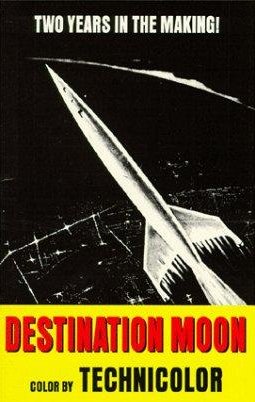Previous FilmDestination Inner Space
Next FilmDestination Moonbase-Alpha
Destination Moon 1950
 | One of the first science fiction films to attempt a high level of accurate technical detail tells the story of the first trip to the Moon. |
The Cast
| John Archer | - | Jim Barnes |
| Warner Anderson | - | Dr. Charles Cargraves |
| Tom Powers | - | General Thayer |
| Dick Wesson | - | Joe Sweeney |
| Erin O'Brien-Moore | - | Emily Cargraves |
| Steve Carruthers | - | Businessman at Meeting |
Film Trivia
The Woody Woodpecker cartoon used in the movie was updated and then used by NASA to explain space travel to the public.
The panoramic view of the lunar scenery was a Chesley Bonestell painting 13 feet long, mounted on wheels and rolled past a stationary camera. To make the stars appear brightly luminous, 534 holes were punched in the painting and illuminated from behind.
The effects of acceleration is shown by the way the actor's faces distort. According to a magazine article this was done by gluing thin strips of flesh-colored fabric on their faces. The fabric was in turn tied to fishing line which was passed through the "acceleration couches" and pulled by crew members to stretch the skin.
In order to make the space suits appear to be in a vacuum they were padded to make them seem inflated. The padding and the studio lights made the suits so hot the actors could wear them for only a few minutes at a time.
The rocket uses water, heated by a nuclear reactor, as reaction mass. This system, although with electrical heating, is actually occasionally used for small unmanned rockets for scientific research. Both the US and the Soviet Union tried to build (jet) airplanes on the principle but abandoned the concept because a flying nuclear reactor was too risky.
Although no date appears on the newspaper, nor does the year appear on the calendar, having the month of June begin on a Tuesday suggests that the film takes place in the year 1954. Subsequent years with matching calendars include 1965, 1971 and 1982.
While planning the famous EVA rescue scene (in which an oxygen bottle is used as a makeshift propulsion unit) the film makers considered using a shotgun as the means by which John Archer retrieves Warner Anderson when he drifts away from the rocket in space. Thankfully they changed their minds; a shotgun seems like an inappropriate piece of equipment to take to a lifeless, airless satellite. However, the shotgun concept was used in the final film during Woody Woodpecker's cartoon demonstration of rocket propulsion which is shown to the millionaire industrialist who finances the Moon trip.
The twelfth episode of the NBC radio series "Dimension X" was entitled "Destination Moon" and was based on Robert A. Heinlein's final draft of the film's shooting script. During the broadcast on June 24, 1950, the programme was interrupted by a news bulletin announcing that North Korea had declared war on South Korea, marking the beginning of the Korean War.
Heinlein actually published a third Moon-trip story in 1950, a novelette featured in the September issue of Short Stories Magazine under the title "Destination Moon". This version is so similar to the film it was probably intended as a promotional piece, but it does include one fascinating story element not in the film. The explorers find evidence of previous lunar visitors either Russians or aliens, they aren't sure which.
Chesley Bonestell, famed artist of the celestial realm, provided matte paintings and designed the lunar surface. Art director Ernst Fegté added the fractured lava bed feature which resembled a cracked lake bottom. The cracks diminish in scale as they recede from the camera, creating a forced perspective which enhanced the depth of the set. This blend of technical accuracy and artistic excellence is the key to the success of "Destination Moon".
This marked the first time that Grace Stafford (cartoon producer Walter Lantz's wife) did the voice of Woody Woodpecker.
A massive campaign was undertaken to create public awareness of the film during its production. This campaign also attracted the attention of independent producer Robert L. Lippert who rushed a low budget space travel film, Rocketship X-M (1950), into production to capitalize on this campaign. Legal action forced Lippert to modify the campaign for his film. Material sent to exhibitors for "Rocketship X-M" carried the disclaimer "This is not 'Destination Moon'." Lippert was able to have "Rocketship X-M" into general release more than three weeks before this film had its preview engagements.
Although many reviewers connect "Destination Moon" with Heinlein's 1950 novel "Rocketship Galileo", the film's story has much more in common with Heinlein's novelette "The Man Who Sold the Moon", also published in 1950.
The cracked surface of the moon is reminiscent of a dried lake bed. Bonestell knew this was scientifically inaccurate, but used it to give a sense of perspective to the lunar panorama.
In 1951 Marvin Fisher (music) and Roy Alfred (lyrics) wrote a song called "Destination Moon" which was recorded by Nat "King" Cole, Dinah Washington, the Ames Brothers, Lester Young and others. The lyrics referenced space travel and were clearly inspired by the movie - "Come and take a trip in my rocket ship/We'll have a lovely afternoon/Kiss the world goodbye and away we fly/Destination Moon" - but Fisher's melody had no connection to the music Leith Stevens composed for the film.
Of the film's 90-minute runtime, only half actually shows the trip to the Moon. The film's entire first half is devoted to the construction of the rocket and to giving reasons for going to the Moon in the first place.
Dick Wesson's film debut.